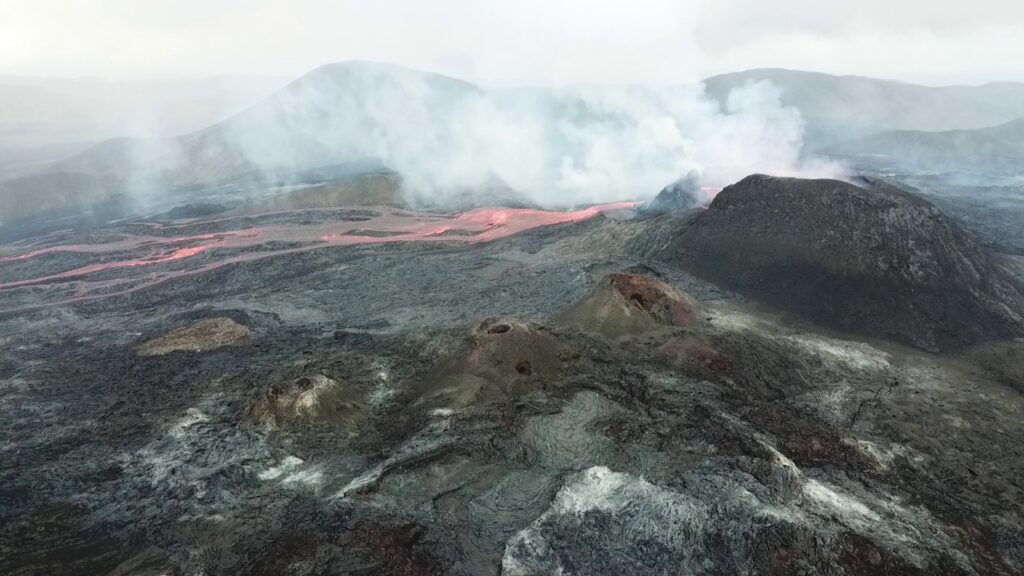Have you heard about the latest news in Iceland? There are rumors that a volcanic eruption is expected at Fagradalsfjall. Sounds amazing right!
Iceland, a country renowned for its vibrant geological activity. It is experiencing a series of earthquakes near its capital city, Fagradalsfjall. The tremors have caught the attention of both geologists and locals, who are becoming increasingly worried. There is a possibility that these tremors might be a sign of an impending eruption at the Fagradalsfjall volcano.
Researchers are paying close attention to the seismic activity, carefully monitoring the situation to determine the chances and possible consequences of an eruption. In this article, we will explore the recent seismic events, their importance, and the potential outcomes of an eruption.
News About Volcanic Eruption at Fagradalsfjall
Since the beginning of April, the Fagradalsfjall peninsula has been measuring rising land. It is a clear sign that magma is building below the surface. This was reported yesterday. Iceland’s two most recent eruptions happened in 2021 and 2022 on the peninsula. As of early yesterday, it didn’t look like an explosion would happen soon. But at Fagradalsfjall on the Reykjanes peninsula, there have been more than 1,200 earthquakes since 10 p.m. yesterday. There have been eight earthquakes with magnitudes greater than 3. It is thought that the biggest earthquake was between 3.6 and 3.7.
At 9 a.m., scientists from the Icelandic Meteorological Office and the University of Iceland will talk about the situation with people from the Department of Civil Protection and Emergency Management.
Unsettling Seismic Swarm at Fagradalsfjall
In recent days, Iceland has seen a significant rise in seismic activity. More than 1,200 earthquakes have been detected in the Fagradalsfjall. The tremors, which have varied in intensity from small to medium, have mainly occurred near Fagradalsfjall.
This stratovolcano is located about 30 kilometers southwest of Reykjavik. Scientists believe that the recent increase in both the frequency and intensity of earthquakes could be attributed to the movement of magma beneath the Earth’s surface.
The seismic swarm in the Reykjanes Peninsula of Iceland has caught the attention of geologists, seismologists, and residents. The recent rise in earthquake activity has caught the attention of people. More than 1,200 earthquakes are recorded. This has raised concerns as it might signify a potential volcanic eruption at Fagradalsfjall.
Most of the earthquakes in the swarm have been quite small. They range in magnitude from 1.0 to 4.0 on the Richter scale. On the other hand, a few moderate tremors, with magnitudes of around 5.0, have been documented as well. The increasing frequency and intensity of earthquakes have led many to wonder if a major geological event could be approaching.
The reason behind the seismic swarm is the active tectonic forces in the region. Iceland is located on the Mid-Atlantic Ridge, a boundary where the Eurasian and North American tectonic plates are separating. Iceland’s geological setting makes it very susceptible to volcanic activity and earthquakes.
According to scientists, the recent earthquakes near Fagradalsfjall are thought to be connected to the movement of magma beneath the surface. When magma makes its way up through the crust of Earth, it faces resistance from the rocks around it. This resistance puts stress on the magma, which eventually causes it to fracture. When fractures occur, they release energy in the form of seismic waves. These seismic waves are then detected and identified as earthquakes.
The seismic swarm is happening around Fagradalsfjall volcano, which adds more evidence that an eruption might be coming. Fagradalsfjall is a volcano that belongs to the Krýsuvík volcanic system, which has a long history of eruptions spanning thousands of years.
The most recent eruption at Fagradalsfjall occurred earlier this year, starting in March 2021 and continuing for a few months. The recent volcanic activity suggests that the volcano is still capable of erupting.
Scientists are keeping a close eye on the seismic activity. They are also looking into other geophysical factors to grasp the situation completely. Measurement of ground deformation, like those obtained from GPS and satellite data, offer valuable information about changes in the Earth’s surface. These measurements can help us understand if the ground is swelling or sinking, indicating movement in the magma beneath the surface. To measure the intensity and potential hazards of volcanic activity. Scientists also closely monitoring the gas emissions, including sulfur dioxide.

The ongoing series of earthquakes is a clear reminder of how Iceland’s geology is constantly changing and moving. Although it’s impossible to say when or if an eruption will happen, the authorities are being proactive to keep the public safe. There are plans in place for evacuations, and emergency response teams are ready to go. We are also keeping the lines of communication open with the communities that may be affected.
The recent series of earthquakes near Fagradalsfjall volcano is a clear reminder that Iceland’s beautiful natural attractions also carry certain risks.
However, this situation also allows scientists to further their knowledge of volcanic processes, improve monitoring methods, and collect important data that can be used to better assess volcanic hazards in the future. As Icelanders and researchers stay alert, the world eagerly observes the unfolding of this fascinating geological spectacle.
Signs of an Impending Eruption in Iceland
Geological studies and measurements of how the ground moves have given us important information about what is happening under Fagradalsfjall. These signs point to magma intrusions, which happen when molten rock rises from deeper levels and gathers near the top.
As the lava pushes through the crust of Earth, it can cause earthquakes because it puts so much pressure on the rocks and breaks them. So, the current swarm of earthquakes shows that magma is actively moving toward the surface, which could cause an explosion.
Monitoring and Preparedness
If Fagradalsfjall erupts, it will likely produce a small, effusive eruption characterized by the flow of lava instead of explosive activity. Even so, these events can still cause problems, such as releasing volcanic gases, infrastructure damage, and ash, causing problems with air traffic. But because the volcano is far from many people, experts do not expect it to pose much of a threat to human life.
Potential Impact of an Eruption in Iceland
If Fagradalsfjall erupts, it is likely to be a small, effusive eruption marked by the flow of lava rather than explosive action. Even so, these events can still cause problems, such as the release of volcanic gases, damage to infrastructure, and problems with air traffic caused by ash. But because the volcano is far from many people, it is not expected to pose much of a threat to human life.
Tourist Attraction and Scientific Opportunity in Iceland
The last eruption at Fagradalsfjall, which started in March 2021, was very interesting because it gave people a rare chance to see a volcanic event up close. The eruption became a famous tourist spot because people could watch the mesmerizing flow of lava and the creation of new land. From a scientific point of view, it gave experts important information they could use to study how volcanoes work and track how the landscape changes.
You can check out our reviews to make sure you are booking a safe and unforgettable tour with us.
Conclusion
The ongoing swarm of earthquakes near Fagradalsfjall volcano in Iceland has raised concerns about a potential eruption. The seismic activity indicates the movement of magma beneath the surface, suggesting that an eruption may be imminent. However, scientists and authorities are closely monitoring the situation to ensure the local population’s and visitors’ safety. While an eruption at Fagradalsfjall has the potential to impact the region, it is also an opportunity for scientific research and a testament to the geologically dynamic nature of Iceland.


